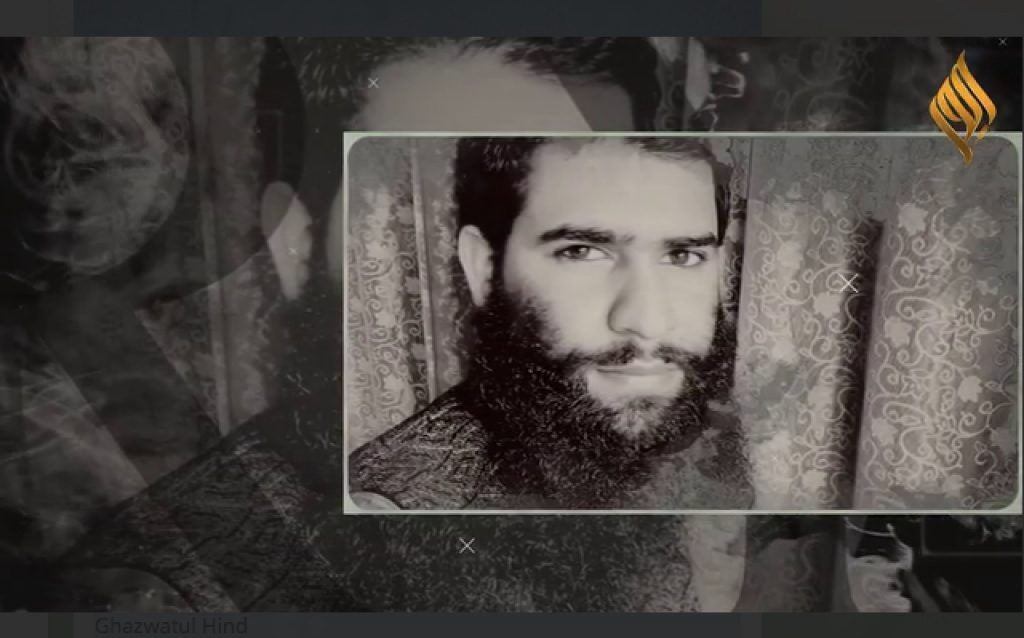
Al Qaeda has reacted to the death of Zakir Musa, a young jihadist commander killed by Indian forces on May 23, by releasing a glowing eulogy and a video promoting the group’s efforts in Kashmir. Musa led Ansar Ghazwat-ul-Hind (AGH), an al-Qaeda linked outfit that was established in 2017.
The eulogy was recorded by Usama Mahmood, who has long served as the spokesman for al Qaeda in the Indian Subcontinent (AQIS). As Sahab, the propaganda arm for al Qaeda’s senior leadership and AQIS, released the audio recording and a written transcript on June 6.
Mahmood’s encomium was accompanied by a banner, seen below, of Musa dressed in his stylized jihadist garb.

The “shocking news of the martyrdom of brother Zakir Musa” has “filled the hearts of the Mujahideen here in Afghanistan” with a “grief” that is “equal” to that “of our Kashmiri brothers,” Mahmood says. The implication is that Mahmood recorded his tribute from inside Afghanistan.
Mahmood says that Musa’s life is a “message” and an “invitation” for other Muslims to join the jihadist revolution. Mahmood claims that when one dies for the cause of Allah, fighting for “freedom from disbelief,” he hasn’t died at all. Instead, according to the AQIS man, Musa lives on, with his message becoming even stronger, inspiring others to learn the true path to independence and then act accordingly. Mahmood says that despite a “number of obstacles” put in place by “the the Hindu army,” “more than 40,000 people of Kashmir” attended Musa’s funeral. This is evidence that Musa’s jihadist call has spread, the AQIS spokesman claims. He appeals to every Muslim and mujahideen in Kashmir to similarly heed the fallen commander’s message.
Mahmood compares Musa to a “bright star,” saying that he has joined a “galaxy” of other supposed martyrs who died for the cause. He names Burhan Wani (Musa’s fallen comrade), Afzal Guru (who was executed for his role in the Dec. 2001 attack on Indian parliament), Taliban founder Mullah Omar, Osama bin Laden, and Abdul Rashid Ghazi (a cleric who was killed by Pakistani forces at the “Red Mosque” in 2007) as other leading lights of the jihadi cause who were similarly “martyred.”
Later in the same message, Mahmood again mentions the sacrifice made by Azfal Guru and also names Ghazi Baba, a Jaish-e-Mohammed (JeM) militant who was also implicated in the Dec. 2001 assault on the Indian parliament. JeM has long received the support of parts of the Pakistani military and intelligence establishment.
Mahmood’s references to Azfal Guru and Ghazi Baba are likely no accident.
As FDD’s Long War Journal has previously assessed, AQIS is poaching from Pakistani-backed jihadist groups that are focused on Kashmir. Zakir Musa was part of this effort, as he defected from Hizbul Mujahideen, arguing that it was constrained by its Pakistani sponsor. This is the same message AQIS is spreading. Indeed, Mahmood praises Musa for his dedication to sharia at all costs. According to al Qaeda, one of the alleged defects of the more nationally-focused Pakistani fighting outfits is that they are willing to compromise on the implementation of Islamic law.
Shortly after Mahmood’s tribute to Musa was uploaded online, AQIS also disseminated a new video titled, “The soldiers of Ghazwat ul-Hind.” The video features a jihadist from Srinagar identified as Faisal Ashfaq Butt, whose face is pixelated for security reasons. He is accompanied by two masked men, as jihadi banners wave behind them.

Butt explains that he followed Ghazi Baba’s example, taking up jihad against Indian authorities by executing small-scale operations in Srinagar. Baba encouraged them to target Indian authorities, including security forces and members of parliament, according to Butt.
Butt’s testimony is intended to woo jihadists from Pakistani-sponsored groups into al Qaeda’s fold. Butt claims that he, like JeM’s Ghazi Baba, realized that the Pakistani state hindered the jihad in Kashmir for its own reasons. The AQIS figure portrays his group as the only one worth fighting under.
Al Qaeda’s ties to militant organizations focused on Kashmir go back decades. Al Qaeda has often relied on these same groups to deepen its bench of talent, bringing in commanders such as Ilyas Kashmiri and Rashid Rauf to replace fallen lieutenants and expand its talent pool. However, the formation of AGH marked a new turn in al Qaeda’s ambitions for Kashmir, as Ayman al-Zawahiri’s men decided to stand up their own enterprise.
Thus far, al Qaeda’s presence in the Kashmiri struggle appears to be small. Only a limited number of fighters are shown in AQIS’s “The soldiers of Ghazwat ul-Hind.” But the group is undoubtedly hoping that the memory of Musa draws even more fighters into its ranks. And AGH has already announced Musa’s successor.

On June 5, AGH’s spokesman, a jihadist known as Abu Ubaidah, released an audio tribute to Musa titled, “He Kept His Promise.” The message was spliced together with images of Musa to form a short video. In addition to honoring Musa, Abu Ubaidah also said that AGH had named a new emir, Abdul Hameed Lelhari (also known as Abbas Musa). His deputy emir is Ghazi Ibrahim.
AGH supporters have also shared a video allegedly recorded by Musa during his final hours. Musa recorded the footage of himself closeup, his eyes nervously darting from one side of the room to another as Indian forces closed in.
“My Kashmiri people,” Musa said, the “solution of our struggle is only jihad” and all “other means” are false. He asked his supporters to keep him in their prayers, and to “support the other brothers in” AGH’s ranks.
Time will tell if Musa’s message truly catches on, and if al Qaeda can capitalize on his memory.
On May 26, supporters of AGH shared Zakir Musa’s final, self-recorded video online. A screen shot from the footage can be seen below:

